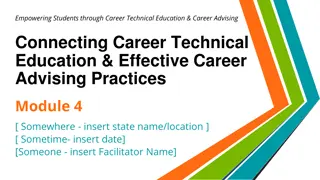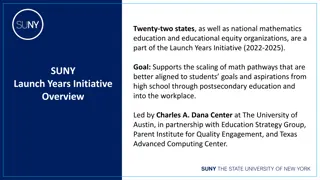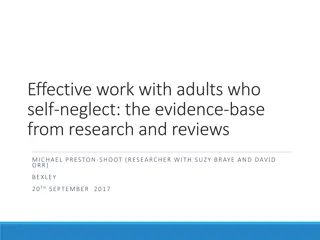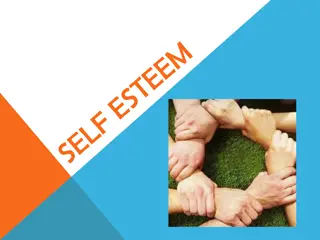
Shifting to a Leader of Others: Key Distinctions and Skills in Educational Leadership
Explore the essential distinctions between being a Leader of Self and a Leader of Others in the educational setting. Discover the key skills and prerequisites needed to transition successfully, from building relationships to effective communication and ethical leadership practices.
Download Presentation

Please find below an Image/Link to download the presentation.
The content on the website is provided AS IS for your information and personal use only. It may not be sold, licensed, or shared on other websites without obtaining consent from the author. If you encounter any issues during the download, it is possible that the publisher has removed the file from their server.
You are allowed to download the files provided on this website for personal or commercial use, subject to the condition that they are used lawfully. All files are the property of their respective owners.
The content on the website is provided AS IS for your information and personal use only. It may not be sold, licensed, or shared on other websites without obtaining consent from the author.
E N D
Presentation Transcript
Guide 1 Expanding Your Impact in PSJA: Shifting from a Leader of Self to a Leader of Others
Leader of Self to Leader of Others From Leader of Self to Leader of Others Leader of Campus As you grow in your PSJA staff leadership level, you expand your impact on the campus. Leader of Leaders Leader of Others At every level, Leaders receive development and support. All leaders must apply on the PSJA jobs website in order to be considered for a new role. Leader of Self Students
Leader of Self to Leader of Others This guide outlines key distinctions in shifting from a Leader of Self to a Leader of Others A Leader of Self is an Individual contributor, team player, and role model for junior/new team members; a Leader of Others leads a team and is responsible for delivering results through others. While these roles will look different at the Elementary, Middle and High School levels, we have outlined the general key skills and abilities needed for success on any campus. Prerequisites for Leader of Others Roles: Example Leader of Others Roles: Leader of Self Leader of Others While prerequisites vary by role, requirements for a Leader of Others role generally include: Teachers Librarians Counselors Nurses Teacher Aides Social Workers + More Collaborative Learning Leader Content Department Heads Grade Level Chair Instructional Coach Bachelor s degree, Valid Texas teaching certificate 3+ years of successful teaching Please note: Reviewing these resources does not guarantee a new position: if you d like to be considered for a new role, please visit the PSJA Jobs page to apply.
Leader of Self to Leader of Others Key shifts in Positive Engagement See next page for aligned learning opportunities Spirit of PSJA Competencies Leading Self (level-specific behaviors) Leading Others (level-specific behaviors) Builds Relationships Actively welcomes others and cultivates sense of belonging among colleagues, students, and parents/caregivers that empowers participation and collaboration in the learning process Cultivates team members feeling of belonging through words and actions, including reinforcing team, school, and district goals and articulating importance of individual work to these goals Key Distinctions A Leader of Self develops trusting relationships with students and parents/caregivers, as well as peers for collaboration A Leader of Others participates in cultivating an environment of team productivity, and builds trusting relationships with a wider range of stakeholders Communicates Effectively Effectively communicates information both orally and in writing to students and parents/caregivers in a manner that instills confidence in the school and builds a common sense of purpose regarding the educational success of the students Models and coaches effective verbal and written communication for team members, facilitating the dissemination of information from campus and district leadership with fidelity, clarity, speed, and careful consideration of importance, relevance, and volume Key Distinctions A Leader of Self focuses on maintaining strong lines of communication with students, parents/caregivers, and colleagues A Leader of Others focuses on disseminating information effectively to team members, coaching team members to improve their communication skills, and maintaining strong lines of communication with students, parents/caregivers, and team members Models Ethics Establishes trust with students and parents by acting in ways that consistently reflect high standards of honesty, fairness, and confidentiality and reinforcing these behaviors in students and colleagues Establishes trust with team members by modeling high standards of honesty, fairness, and confidentiality, setting clear and consistent expectations for team members, and recognizing and appreciating specific behaviors in line with district values Key Distinctions A Leader of Self focuses on modeling ethics as a classroom leader and team member A Leader of Others broadens their leadership focus as a team leader to supporting systems and holds team members accountable Exhibits Professionalism Recognizes own emotional responses and actively works to exercise control over how emotions inform actions to support campus goals and student learning Supports team function by encouraging self-awareness around emotions, behaviors, and mindset in team members and providing appropriate resources and support for cultivating emotional intelligence Key Distinctions A Leader of self focuses on how personal actions align with campus goals In addition to focusing on their own work, A Leader of Others leverages coaching and feedback to support team members in aligning their actions to campus goals
Leader of Self to Leader of Others Expanding your impact in Positive Engagement Overall Key Shift in Positive Engagement: From executing results to delivering results through others by building relationships and effective communication Spirit of PSJA Competencies Job-embedded experiences & resources for growth Look for opportunities to: Builds Relationships -Inclusive Leadership: Effectively Leading Diverse Teams (article) -ASCD Webinar: From Behaving to Belonging: The Inclusive Art of Supporting Students Who Challenge Us Invite feedback and ideas from students and colleagues Create learning opportunities that build trust among students and/or staff Implement strategies to maximize student voice in your classroom and ensure all students are included Communicates Effectively Creating a culture on collaborative family engagement (article) -Teaching Tolerance: Guide to Differentiated Instruction Evaluate your own systems for communicating with parents and colleagues, and reading and responding to emails/phone messages Adapt communication to address stakeholder needs Models Ethics Engage students and colleagues in discussions about campus core values Develop a personal vision statement aligned with campus core values Exhibits Professionalism -Personalized Professional Learning: A Job-Embedded Pathway for Elevating Teacher Voice (book) Practice and model effective listening Provide feedback to colleagues in a growth- oriented manner Find a colleague who wants help with feedback. Coach your colleague over a series of engagements to include conferencing and observation to improve their feedback practice (both giving and receiving)
Leader of Self to Leader of Others Key shifts in Student-Centered Excellence See next page for aligned learning opportunities Spirit of PSJA Competencies Leading Self (level-specific behaviors) Leading Others (level-specific behaviors) Demonstrates Expertise Demonstrates expertise for role and commitment to continuous learning to maximize impact on students Demonstrates expertise and models continuous desire to learn; Engages team in building and implementing expertise and continuously exploring better ways to meet team goals Key Distinctions A Leader of Self is responsible for the completion of their own assigned tasks and goals A Leader of Others is responsible for continuously finding a way to improve team outcomes, and develops increasingly specific expertise in instructional leadership Establishes a Shared Vision Engages campus vision by providing feedback and actively seeking to align individual efforts Engages team in interpreting and incorporating campus vision into their work Key Distinctions A Leader of Self focuses on his/her own impact and alignment to campus vision A Leader of Others spends significant time cultivating a shared vision among the team and supporting team members to incorporate the campus vision into their individual work Implements Plan Effectively utilizes time to accomplish goals through effective organization and prioritization Supports team members to maximize use of time for activities related to campus vision and goals, prioritizing time and space for highest leverage activities Key Distinctions A Leader of Self completes individually assigned tasks A Leader of Others is responsible for delegating work and creating project plans for the team to accomplish goals Expects Results Contributes individual effort to meet and exceed external standards of accountability Engages team members in implementing aligned practices to meet and exceed external standards of accountability Key Distinctions A Leader of Self monitors their own progress aligned to campus and district goals A Leader of Others spends time monitoring not only the results of their own work, but also monitoring team progress and ensuring the greatest impact team-wide
Leader of Self to Leader of Others Expanding your impact in Student-Centered Excellence Overall Key Shift in Student-Centered Excellence: From executing results to delivering results through others using skills in planning and student-centered expertise Spirit of PSJA Competencies Job-embedded experiences & resources for growth Look for opportunities to: Demonstrates Expertise The Principles of Adult Learning (article) Conduct research about emerging practices related to an issue your team is currently facing; share research and propose a strategy to incorporate the findings into your team s work Article: Using Student Achievement Data to Support Instructional Decision-making Share insights from professional development with colleagues Establishes a Shared Vision Developing the Leader Within You (book) Contagious Culture: Show Up, Set the Tone, and Intentionally Create an Organization that Thrives (book) Design an innovation challenge to elicit ideas from colleagues about new ways of working or to solve a pressing problem Set and monitor goals with colleagues Implements Plan Increase time spent setting data-driven classroom goals Article: 6 steps for aligning student tasks with learning targets Use data to analyze, pinpoint, and propose a solution to a problem you re facing in your classroom. Implement the solution and evaluate its effectiveness. Achievement First s process for helping teachers set goals Expects Results Set high expectations and measurable goals for students Use concrete data to set achievable and meaningful goals for students aligned to campus goals Encourage others to be creative and aspirational in goal setting Article: Using Student Achievement Data to Support Instructional Decision-making Coaching for Equity (book) Teachers Expectations Can Influence How Students Perform (Article) Create a progress monitoring structure for yourself. Implement it. Evaluate its success and share with your team members for feedback.
Leader of Self to Leader of Others Key Shifts in Joint Empowerment See next page for aligned learning opportunities Spirit of PSJA Competencies Leading Self (level-specific behaviors) Leading Others (level-specific behaviors) Builds Capacity Engages in opportunities to build capacity, by building on strengths and addressing needs Leads team in developing individual and team goals for development in alignment with campus goals and facilitates conversations to allow team members to learn from one another Key Distinctions in Builds Capacity A Leader of Self focuses on their own individual growth and development to maximize their own impact A Leader of Others uses coaching and leadership skills to maximize the work of individual contributors and team as a whole. A Leader of Others may also be involved in some hiring decisions. Promotes collaboration Participates as a member of collaborative communities Fosters mutual respect and trust among team members to maximize collaborative work Key Distinctions in Promotes Collaboration A Leader of Self develops relationships with peers for collaboration and looks to managers for development and support A Leader of Others cultivates a collaborative environment and needs skills to facilitate effective team decision-making Inspires action Assumes personal responsibility for upholding campus/district vision for all students Cultivates team commitment to achieve campus/district vision for all students Key Distinctions in Inspires Action A Leader of Self focuses on self-driven action to achieve individual goals A Leader of Self uses both direct and indirect influence on others to achieve goals Develops leaders Aware of own strengths and seeks assignments for development, according to career goals Identifies and promotes strengths in team members to support their development within the campus and district Key Distinctions in Develops Leaders A Leader of Self looks to others for feedback about individual contributions A Leader of Others receives feedback from their managers, but also spends time coaching and providing specific, constructive feedback to grow team and team members
Leader of Self to Leader of Others Expanding your impact in Joint Empowerment Overall Key Shift in Joint Empowerment: From executing results to delivering results through others by building the capacity of others and developing leaders Spirit of PSJA Competencies Job-embedded experiences & resources for growth Look for opportunities to: Builds Capacity The Art of Coaching (book + tools) Offer to mentor a colleague with less experience than you. Identify mentorship skills to practice. Evaluate success using mentee feedback Learning Forward Webinar: My Teaching Partner; Proven strengths-based coaching model that raises student achievement and engagement Practice skills as a mentor with colleagues who have less teaching experience Practice providing differentiated support to address individual student needs Promotes collaboration Making Team Differences Work (article) Facilitating Teacher Teams and Authentic PLCs: The Human Side of Leading People, Protocols, and Practices (book) Article: 3 Ways to Model Collaboration and Partnership in Schools and Classrooms Collaborate with team members to build strong systems for parent/community communication Actively contribute to team learning experiences and encourage participation of other team members Inspires action Facilitate portions of team meetings Dare to Lead book study (book and guiding workbook) Develops leaders Provide feedback to colleagues in a growth- oriented manner Big Potential (book)
Leader of Self to Leader of Others Key Shifts in Adaptive Innovation See next page for aligned learning opportunities Spirit of PSJA Competencies Leading Self (level-specific behaviors) Leading Others (level-specific behaviors) Scans environment Demonstrates understanding of own role in campus system and aligns efforts to campus goals Helps team understand campus role and accountability to larger educational system Key Distinctions in Scans Environment A Leader of Self is accountable for results within their role- assigned area of impact A Leader of Others holds themselves and their team accountable for collective impact in line with campus and district goals Champions solutions Open to new ideas/perspectives from colleagues, students, and parents/caregivers Receptive to new ideas/perspectives from team members Key Distinctions in Champions Solutions A Leader of Self effectively solves problems pertaining to their role-assigned work A Leader of Others supports others in solving problems and encourages the team to think and act in innovative ways to achieve goals Manages change Believes in own ability to adapt and respond to challenges Supports team persistence and resilience in face of challenges Key Distinctions in Manages Change A Leader of Self must be adaptive and solutions-oriented with faced with challenges in their own work A Leader of Others must consider and respond to short and long-term challenges while creating goals and delegating tasks Acknowledges outcomes Persists in the face of initial failure and learns for continuous improvement Consistently leads team to evaluate areas of need and examine results in order to improve Key Distinctions in Acknowledges Outcomes A Leader of Self monitors their own progress and reflects on their achievements and growth areas A Leader of Others coaches others to recognize their areas of need and examine results in order to improve
Leader of Self to Leader of Others Expanding your impact in Adaptive Innovation Overall Key Shift in Adaptive Innovation: From executing results to delivering results through others by effectively managing change and championing solutions Spirit of PSJA Competencies Job-embedded experiences & resources for growth Look for opportunities to: Scans environment Align your practice to the campus vision Developing the Leader Within You, chapter 8 (book) Find a colleague seeking support in staying accountable to their goals. Identify a coaching strategy and try it; evaluate effectiveness by asking for feedback. Teach students the campus vision and highlight the vision's values and attributes during instruction Champions solutions Support colleagues in solving problems Engage others in developing innovative solutions and creates opportunities to test Explore free, self-paced courses on PBS TeacherLine to inspire and reinvigorate your teaching strategies Manages change Model a growth mindset and support colleagues in times of change Dare to Lead book study (book and guiding workbook) Acknowledges outcomes Administrators: What to ask of your data (article) Six Steps to Equitable Data Analysis (article) The Art of Coaching Teams (book) chapters 2 and 6 Resource: Giving students precise praise Evaluate your own systems for recognizing students in your classroom Spend time with other teachers (campus or district) learning how they recognize the growth of their students Find meaningful ways to recognize students and colleagues Encourage students to see mistakes as learning opportunities






















